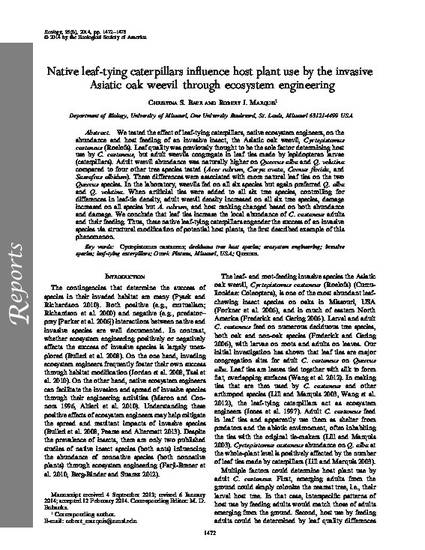
Article
Native leaf‐tying caterpillars influence host plant use by the invasive Asiatic oak weevil through ecosystem engineering
Ecology
(2014)
Abstract
We tested the effect of leaf‐tying caterpillars, native ecosystem engineers, on the abundance and host feeding of an invasive insect, the Asiatic oak weevil, Cyrtepistomus castaneus (Roelofs). Leaf quality was previously thought to be the sole factor determining host use by C. castaneus , but adult weevils congregate in leaf ties made by lepidopteran larvae (caterpillars). Adult weevil abundance was naturally higher on Quercus alba and Q. velutina compared to four other tree species tested (Acer rubrum , Carya ovata , Cornus florida , and Sassafras albidum ). These differences were associated with more natural leaf ties on the two Quercus species. In the laboratory, weevils fed on all six species but again preferred Q. alba and Q. velutina . When artificial ties were added to all six tree species, controlling for differences in leaf‐tie density, adult weevil density increased on all six tree species, damage increased on all species but A. rubrum , and host ranking changed based on both abundance and damage. We conclude that leaf ties increase the local abundance of C. castaneus adults and their feeding. Thus, these native leaf‐tying caterpillars engender the success of an invasive species via structural modification of potential host plants, the first described example of this phenomenon.
Disciplines
Publication Date
June, 2014
DOI
10.1890/13-1689.1
Citation Information
Christina Baer and Robert Marquis. "Native leaf‐tying caterpillars influence host plant use by the invasive Asiatic oak weevil through ecosystem engineering" Ecology Vol. 95 Iss. 6 (2014) Available at: http://works.bepress.com/robert-marquis/74/
